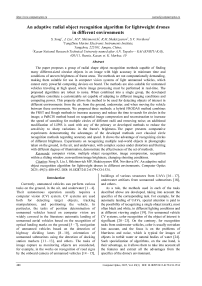An adaptive radial object recognition algorithm for lightweight drones in different environments
Автор: Song S., Liu J., Shleimovich M.P., Shakirzyanov R.M., Novikova S.V.
Журнал: Компьютерная оптика @computer-optics
Рубрика: Обработка изображений, распознавание образов
Статья в выпуске: 3 т.49, 2025 года.
Бесплатный доступ
The paper proposes a group of radial shape object recognition methods capable of finding many different-sized circular objects in an image with high accuracy in minimum time and conditions of uneven brightness of frame areas. The methods are not computationally demanding, making them suitable for use in computer vision systems of light unmanned vehicles, which cannot carry powerful computing devices on board. The methods are also suitable for unmanned vehicles traveling at high speed, where image processing must be performed in real-time. The proposed algorithms are robust to noise. When combined into a single group, the developed algorithms constitute a customizable set capable of adapting to different imaging conditions and computing power. This property allows the method to be used for detecting objects of interest in different environments: from the air, from the ground, underwater, and when moving the vehicle between these environments. We proposed three methods: a hybrid FRODAS method combines the FRST and Hough methods to increase accuracy and reduce the time to search for circles in the image; a PaRCIS method based on sequential image compression and reconstruction to increase the speed of searching for multiple circles of different radii and removing noise; an additional modification of LIPIS is used with any of the primary or developed methods to reduce the sensitivity to sharp variations in the frame's brightness. The paper presents comparative experiments demonstrating the advantages of the developed methods over classical circle recognition methods regarding accuracy and speed. It shows the advantage of recognizing circles of different brightness. Experiments on recognizing multiple real-world objects in photographs taken on the ground, in the air, and underwater, with complex scenes under distortion and blurring with different degrees of illumination, demonstrate the effectiveness of the set of methods.
Computer vision, multiple object recognition, image compression, recognition within a sliding window, non-uniform image brightness, changing shooting conditions
Короткий адрес: https://sciup.org/140310490
IDR: 140310490 | DOI: 10.18287/2412-6179-CO-1534


